Dutchman’s Breeches
The common name from this spring ephemeral comes from its outer "V"-shaped hanging petals that look like a pair of white breeches hung upside-down.
 Found along the Blue Ridge Parkway at MP 367.5.
Found along the Blue Ridge Parkway at MP 367.5.
The landscape of the southern Appalachians is rich in biodiversity, offering you an opportunity to discover flora not found anywhere else in the world. In Asheville, showy native wildflowers bloom with the arrival of spring and progress throughout the year, making Asheville one of the longest wildflower bloom seasons in the country.
Check out Asheville’s wildflower bloom schedule below to learn more about the region’s most prominent native wildflowers and where to find them on your next visit.

The common name from this spring ephemeral comes from its outer "V"-shaped hanging petals that look like a pair of white breeches hung upside-down.
 Found along the Blue Ridge Parkway at MP 367.5.
Found along the Blue Ridge Parkway at MP 367.5.
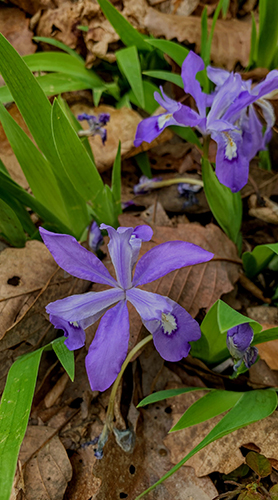
This diminutive iris spreads easily in the forest floor, creating clusters of color ranging from pale blue to lavender.
 Found along the Blue Ridge Parkway at MP 379 and at The N.C. Arboretum.
Found along the Blue Ridge Parkway at MP 379 and at The N.C. Arboretum.
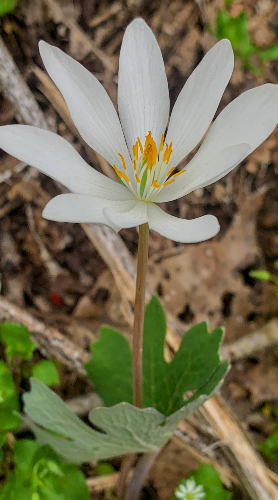
This wildflower's roots produce a yellow-orange dye and its stems produce an orange-red dye favored by Native Americans and textile artists.
 Found along the Blue Ridge Parkway at MP 294 and at the N.C. Arboretum.
Found along the Blue Ridge Parkway at MP 294 and at the N.C. Arboretum.
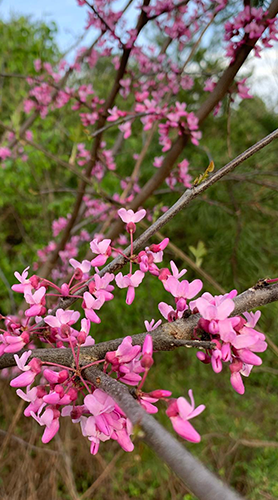
Also known as spicewood, this magenta bare-wood is a member of the Leguminosae or Pea family and displays purplish, pink flowers every spring.
 Found in the wild along forest edges, as well as at the N.C. Arboretum.
Found in the wild along forest edges, as well as at the N.C. Arboretum.
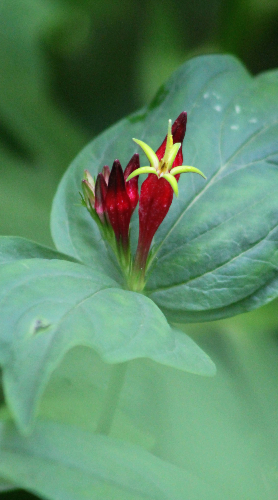
The plant's red blossoms are actually modified leaves, called bracts, that attract bees and ruby-throated hummingbirds essential to pollination.
 Found along the Blue Ridge Parkway at MP 369-371.
Found along the Blue Ridge Parkway at MP 369-371.
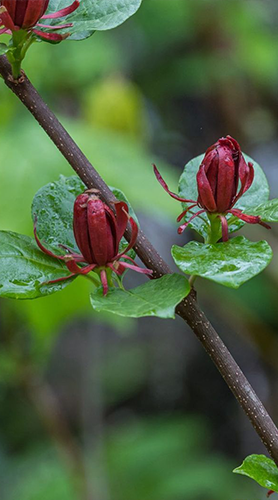
Fragrant leaves, twigs and maroon blossoms distinguish this native shrub (sometimes called strawberry bush).
 Commonly found along streambanks and the N.C. Arboretum.
Commonly found along streambanks and the N.C. Arboretum.
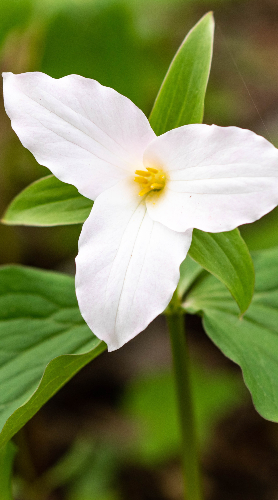
This member of the lily family consists of 39 native species and is also known as Wake Robin, Toadshade and Birthroot.
 Found along the Blue Ridge Parkway at MP 330-340, and 370-375 and The N.C. Arboretum.
Found along the Blue Ridge Parkway at MP 330-340, and 370-375 and The N.C. Arboretum.
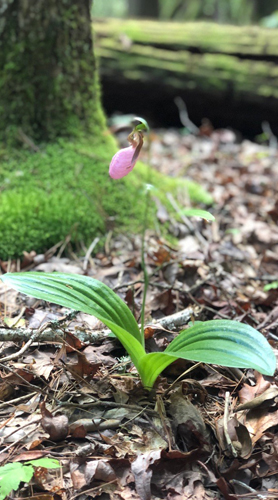
The translation of their botanical name - Cypripedium Acaule - is Venus' shoes, which is a perfect fit for their ballet-slipper pink or yellow blossoms.
 Found at the N.C. Arboretum and Bent Creek Experimental Forest.
Found at the N.C. Arboretum and Bent Creek Experimental Forest.

The common name of this showy native tree is believed to come from a colonial description of the fruit as being edible but not fit for a dog. It is also the official state flower of North Carolina.
 Found growing wild along the Blue Ridge Parkway and at the North Carolina Arboretum.
Found growing wild along the Blue Ridge Parkway and at the North Carolina Arboretum.
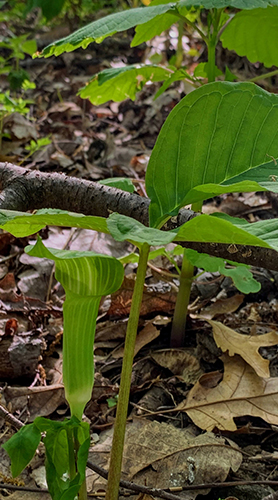
This shy wildflower's name comes from its appearance that resembles a Sunday-morning preacher perched in an old-fashioned pulpit.
 Common in area woodlands and at the Asheville Botanical Garden.
Common in area woodlands and at the Asheville Botanical Garden.

This wildflower contains one or two large umbrella-like leaves and blooms in early May. After it flowers, it produces an apple-like fruit, hence its common name. Its fruit is often consumed by Eastern box turtles (North Carolina’s state turtle), which also disperse the flower’s seeds.
 Found in open woodland areas, along the Blue Ridge Parkway at MP 315-317, 320.8 and 339.5, and at the N.C. Arboretum.
Found in open woodland areas, along the Blue Ridge Parkway at MP 315-317, 320.8 and 339.5, and at the N.C. Arboretum.

This native bloomer is a member of the rhododendron family that favors grassy mountain balds and woodland slopes.
 Found along the Blue Ridge Parkway at MP 308-310, 368-380, 412-423 and at The N.C. Arboretum.
Found along the Blue Ridge Parkway at MP 308-310, 368-380, 412-423 and at The N.C. Arboretum.
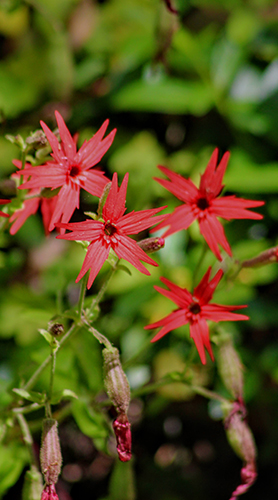
Also known as Indian Pink, this short-lived perennial was named N.C.'s Wildflower of the Year in 2015.
 Found along the Blue Ridge Parkway at MP 339.3, 367-375, 404-408, at the Asheville Botanical Garden and The N.C. Arboretum.
Found along the Blue Ridge Parkway at MP 339.3, 367-375, 404-408, at the Asheville Botanical Garden and The N.C. Arboretum.
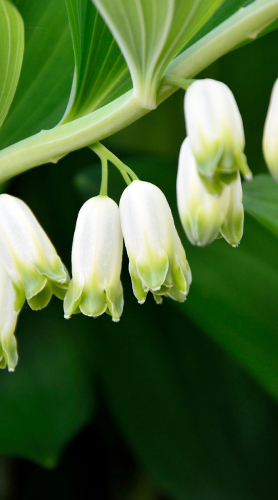
The name of this shade-loving wildflower comes from its roots that some believed possessed scars resembling the ancient Hebrew seal of King Solomon.
 Common along the Blue Ridge Parkway in moist wooded slopes, coves, at the Asheville Botanical Garden, and The N.C. Arboretum.
Common along the Blue Ridge Parkway in moist wooded slopes, coves, at the Asheville Botanical Garden, and The N.C. Arboretum.
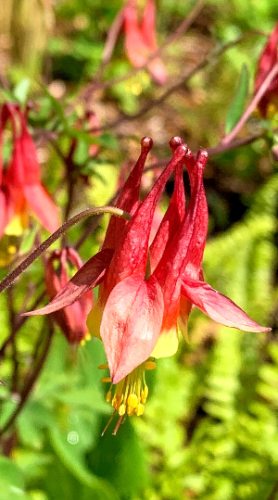
Ancient Greeks and Romans credited this plant to Aphrodite, the goddess of love, while other cultures associated it with foolishness because its blossom resembles a jester's hat.
 Found along the Blue Ridge Parkway at MP 339.3 Picnic Area, 370-378 and at the Asheville Botanical Garden.
Found along the Blue Ridge Parkway at MP 339.3 Picnic Area, 370-378 and at the Asheville Botanical Garden.
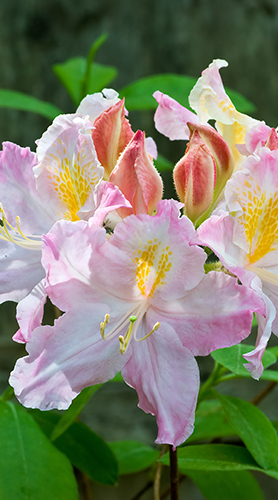
Azalea vaseyi is a rare and endangered species that is native only to the N.C. mountains; it bears the botanical name of George Vasey who discovered it in 1878.
 Found along the Blue Ridge Parkway at elevations between 3,000 and 5,500 feet and at the N.C. Arboretum.
Found along the Blue Ridge Parkway at elevations between 3,000 and 5,500 feet and at the N.C. Arboretum.

This medium-sized rhododendron takes its name from the powerful Catawba Indians; legend has it that its rosy pink flowers appeared following the Catawba's victory over neighboring tribes.
 Found at Craggy Gardens at MP 364 on the Blue Ridge Parkway, the N.C. Arboretum, and elevations around 3,000 feet.
Found at Craggy Gardens at MP 364 on the Blue Ridge Parkway, the N.C. Arboretum, and elevations around 3,000 feet.
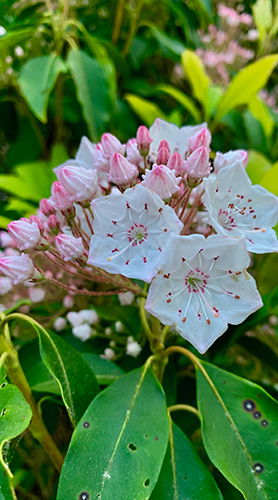
Kalmia latifolia is a member of the heather family; its other names include Ivybush, Calicobush and Spoonbush (so named because Native Americans made spoons from its wood).
 Found along the Blue Ridge Parkway at MP 347.9, 380, 400 and at the North Carolina Arboretum.
Found along the Blue Ridge Parkway at MP 347.9, 380, 400 and at the North Carolina Arboretum.
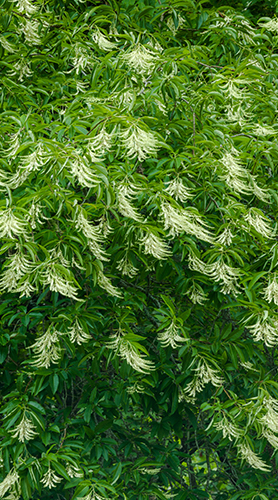
Pioneers used the sap of this native tree to create a fever-treating drink; today we use the dark rich honey produced from its fragrant lily of the valley-like blossoms to sweeten our drinks and food.
 Found along the Blue Ridge Parkway at MP 375-380 and the N.C. Arboretum.
Found along the Blue Ridge Parkway at MP 375-380 and the N.C. Arboretum.
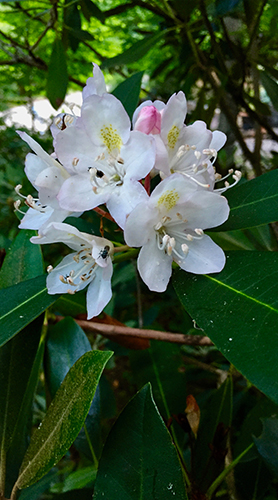
Rhododendron maximum, also known as Big Laurel, forms dense thickets, some as high as 20 feet, that are critical to the health of Southern Appalachian forests and the wildlife that dwell there.
 Found at the N.C. Arboretum and at the Blue Ridge Parkway MP 339.3 Picnic Area, MP 352-353, and MP 455-456.
Found at the N.C. Arboretum and at the Blue Ridge Parkway MP 339.3 Picnic Area, MP 352-353, and MP 455-456.
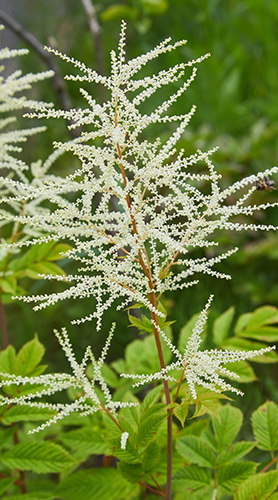
This showy herbaceous perennial (Aruncus dioicus) lives for up to 10 years and can reach six feet in height; Native Americans used the roots to create healing poultices and infusions.
 Found along the Blue Ridge Parkway at MP 337.6, 370-375 and at the Asheville Botanical Garden.
Found along the Blue Ridge Parkway at MP 337.6, 370-375 and at the Asheville Botanical Garden.
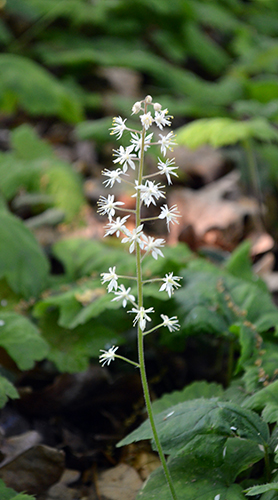
The botanical name -- Tiarella cordifolia -- comes from the Greek meaning little tiara, a reference to the shape of the plant's pistil that reminded early botanists of a Persian turban.
 Found along the Blue Ridge Parkway MP 339.5, 367.7 Picnic Area and at the Asheville Botanical Garden.
Found along the Blue Ridge Parkway MP 339.5, 367.7 Picnic Area and at the Asheville Botanical Garden.
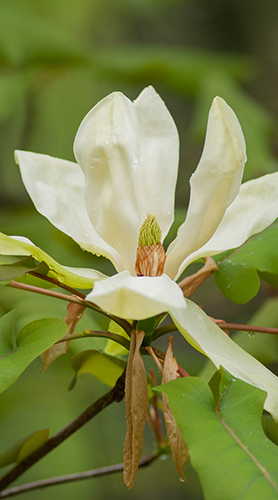
This large-leafed tree (also known as the Mountain Magnolia) produces fragrant blossoms that can grow up to 12 inches in diameter; it is named for the 18th century Scottish botanist John Fraser, who discovered it.
 Found at the North Carolina Arboretum and in woodlands at elevations between 2,000 and 4,000 feet.
Found at the North Carolina Arboretum and in woodlands at elevations between 2,000 and 4,000 feet.
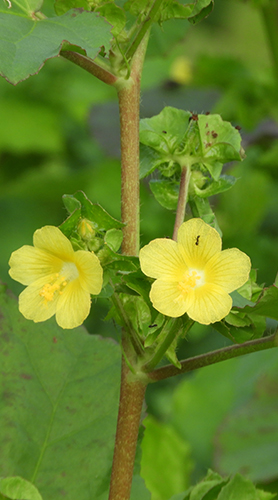
The nectar from this day-blooming member of the evening primrose family supports bees and hummingbirds, while its seeds are a favorite of songbirds.
 Found along sunny roadsides, on banks and rocky outcroppings and in dry forests and meadows throughout the area, and at MP 351-352, 355-360, 370-375 on the Blue Ridge Parkway
Found along sunny roadsides, on banks and rocky outcroppings and in dry forests and meadows throughout the area, and at MP 351-352, 355-360, 370-375 on the Blue Ridge Parkway

This largest and most spectacular native lily prefers moist soil and partial shade; it's orange blooms grow on stalks as high as eight feet and are a favorite of hummingbirds and butterflies.
 Found at the Asheville Botanical Gardens and along the Blue Ridge Parkway at MP 364-368, 406-411.
Found at the Asheville Botanical Gardens and along the Blue Ridge Parkway at MP 364-368, 406-411.

Commonly called Cutleaf Coneflower, this tall wildflower was one of the earliest American species sent back to England by 17th century explorers and grew in the garden of King Charles I.
 Found along the Blue Ridge Parkway at MP 314, 359-368.
Found along the Blue Ridge Parkway at MP 314, 359-368.
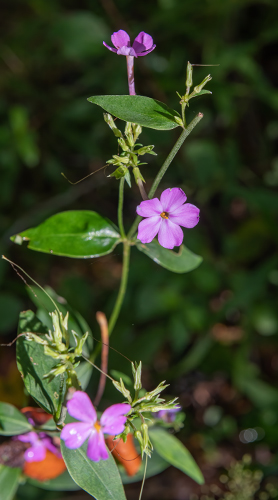
The name Phlox comes from the Latin meaning flame; no surprise, then, that this showy wildflower blooms during the hottest part of the summer in full sun.
 Found at the Asheville Botanical Gardens and at MP 339.3 Picnic Area and 370-380 along the Blue Ridge Parkway
Found at the Asheville Botanical Gardens and at MP 339.3 Picnic Area and 370-380 along the Blue Ridge Parkway
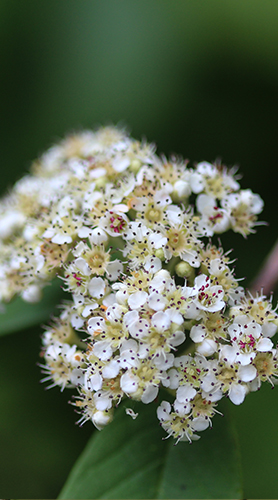
Sorbus americanus is a small understory tree that thrives in cooler climates and sunshine; despite it's name, it is actually a member of the rose family.
 Found at at higher elevations in the spruce-fir forests at Mt. Mitchell and Mt. Pisgah.
Found at at higher elevations in the spruce-fir forests at Mt. Mitchell and Mt. Pisgah.
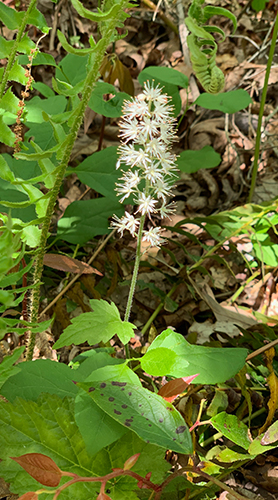
Found in woodland areas with reliably wet, heavy soil, this member of the buttercup family was used by Native Americans to treat snakebite, inflamed lungs and pain during childbirth.
 Found at Asheville Botanical Garden, and at MP 374 along the Blue Ridge Parkway
Found at Asheville Botanical Garden, and at MP 374 along the Blue Ridge Parkway
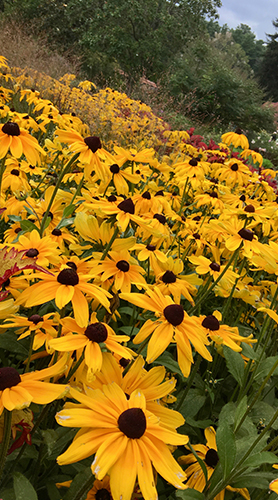
It's said that this wildflower's name comes from a popular post-Elizabethan era poem in which Black-Eyed Susan bids farewell to her Sweet William who is about to set off on a high seas journey.
 Found at the N.C. Arboretum, Asheville Botanical Garden, in fields and along roadsides
Found at the N.C. Arboretum, Asheville Botanical Garden, in fields and along roadsides
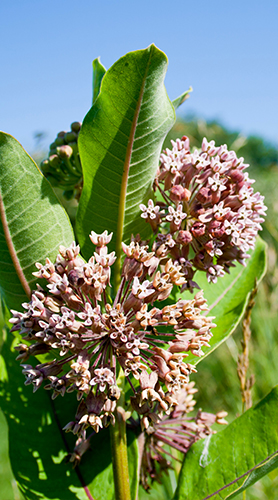
A critical source of food for Monarch butterfly larvae, this tall weed-like plant produces balls of pink and purplish-colored flowers in the summer. Named for its milky sap, this plant has been used for fiber, food and medicine by many for centuries.
 Often found along roadsides and at the N.C. Arboretum.
Often found along roadsides and at the N.C. Arboretum.
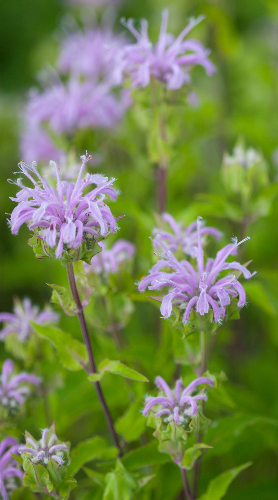
This member of the wild mint family is a favorite among bees, butterflies and hummingbirds; it is also one of the few wildflowers that and tolerate the chemical produced by black walnut trees.
 Found at Asheville Botanical Garden and MP 38.8, 368-374 along the Blue Ridge Parkway
Found at Asheville Botanical Garden and MP 38.8, 368-374 along the Blue Ridge Parkway
Want to view them yourself? See wildflowers galore on one of the Asheville area’s best spring hikes, or check out some of Asheville’s top local spots for spring blooms.

For Visitors
For Media
For Planners
